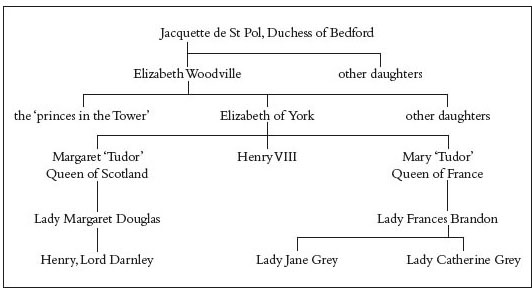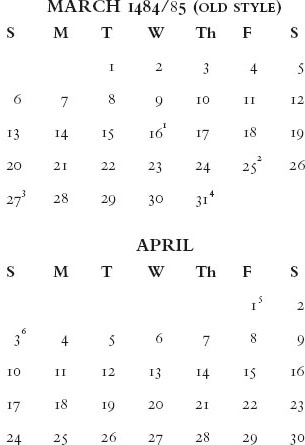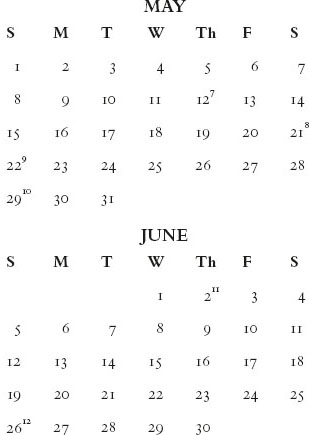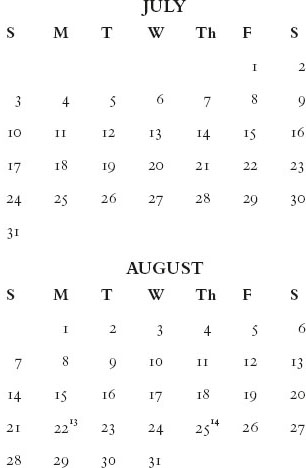The Last Days of Richard III and the Fate of His DNA (28 page)
Read The Last Days of Richard III and the Fate of His DNA Online
Authors: John Ashdown-Hill

Although the fate of the âprinces' is unknown, there is a marble urn in the Henry VII chapel at Westminster which bears their names and purports to contain their bones. The urn was created by Sir Christopher Wren at the behest of Charles II, to house some fragmentary remains which were discovered during some demolition work at the Tower of London in the 1670s. We have no idea from what period these bones date, nor is it known whether they represent boys or girls. The remains have never been subjected to any rigorous scientific examination. Nevertheless, the requisite information which would make it possible to show whether or not these could indeed be the bones of the âprinces' may in due course become available, and I have been struggling with this for some years now.

F
AMILY
T
REE
9: The mtDNA family tree of the âprinces in the Tower' (simplified).
In 1787, the tomb of Mary âTudor', Queen of France and Duchess of Suffolk was opened in St Mary's Church, Bury St Edmunds, Suffolk. The queen's body was found to be well preserved, and locks of her long red hair were cut off as souvenirs. One such lock of hair remains in Bury St Edmunds, where it is displayed at Moyses Hall Museum. Mary âTudor', younger sister of King Henry VIII, was a daughter of Elizabeth of York, and thus the female line niece of the âprinces'. In 2007, I was given permission by the Bury St Edmunds museum authorities to attempt DNA testing of a few strands of this hair. Sadly, however, in the event it proved impossible to open the Bury St Edmunds locket without risking damage both to the locket itself and to the hair. Finally, the attempt had to be abandoned.
But the hair in the Moyses Hall Museum locket is not the only lock of Mary âTudor''s hair in existence above ground. After a prolonged search I located a second locket, and a sample of hair from this locket was tested in the hope of thereby obtaining the mtDNA sequence of the âprinces in the Tower'. The initial tests did not succeed in producing a complete and uncontaminated mtDNA sequence, but a few strands of the hair remain in a sealed container in my keeping, and since DNA testing has progressed in the last few years in may, at some stage, be possible to repeat the attempt.
The obvious alternative line of investigation, which would seek to replicate the research which led to Joy Ibsen in Canada, by identifying a living female-line descendant of Elizabeth Woodville or one of her sisters, is sadly impossible in the case of the âprinces', because research by myself and others has shown that there are now no known living all-female-line relatives of Elizabeth Woodville. Although my work on the DNA of the âprinces' has yet to yield positive results, it goes to show that there are still new avenues of research to be explored, and that in due course more may be known about Richard III. If we keep searching for new sources, new evidence, new approaches, some of the other aspects of Richard's story which have been contentious for the last five centuries may finally be resolved. Philippa Langley's determination to seek the real Richard III beneath a Leicester car park shows very clearly what can be achieved.
Meanwhile, hopefully at some suitable moment in the not too distant future, Richard III's remains will be given an honourable reburial. Provisional plans for a suitable tomb in Leicester Cathedral â just across the road from the Greyfriars site where his body lay for more than 500 years â have already been made. Of course today this cathedral is an Anglican church. Since I myself share Richard III's Catholic faith, I explored with the Dean of Leicester the possibility of the inclusion of elements of Catholic liturgy in plans for the reburial service, together with the invitation of members of the Catholic hierarchy. I was very happy to be reassured upon these points, because one of the things which we do know for certain about Richard III is that his religious beliefs were important to him during his lifetime.
As for the present position, we already know rather more about Richard III than we did before. We have a clear impression of his build and appearance. We know how he died. We know that, like the bodies of many defeated leaders, Richard's corpse was almost certainly mal-treated in the immediate aftermath of his defeat and death. We are now certain of his mitochondrial DNA sequence and have the possibility of learning more about his genetic make-up in the future.
Richard III's historiography has been the victim of more than 500 years of mythology and legends. One of the best-known of these was the story that his body was dug up at the Reformation and thrown into the River Soar. In the first edition of this book, I produced strong evidence against that story, and we can now be absolutely certain that it was nothing but a myth with no basis in fact. How many of the other stories about Richard III, which have been widely believed for centuries, belong in the same category? We cannot be sure. But the final debunking of the âbody in the river' legend and the positive identification of Richard's undisturbed burial at Leicester Greyfriars will hopefully warn the historians of the future to tread very carefully when handling the many other tales that have been passed down to us about Richard III.
Appendix 1
Richard III's Itinerary for 1485
1
MARCH | |
| 1 Tuesday â28 Monday | Westminster |
| [16 Wednesday | death of Queen Anne, Palace of Westminster] |
| [25 Friday | burial of Queen Anne, Westminster Abbey] |
| 28â30 | London (city) |
| 30 | Clerkenwell (Priory St John) |
| 31 | London |
APRIL | |
| 1 Friday â 17 Sunday | London |
| 18 Monday â20 Wednseday | Windsor |
| 22â26 | London |
| 26â30 | Westminster |
MAY | |
| 1 Sunday â 11 Wednesday | Westminster |
| 12â16 | Windsor |
| 17 | Berkhamsted |
| 18â21 | ? |
| 22â31 | Kenilworth |
JUNE | |
| 1 Wednesday | Coventry |
| 2â5 | ? |
| 6 | Kenilworth |
| 7â8 | ? |
| 9â30 | Nottingham |
JULY | |
| 1â31 (? There are gaps) | Nottingham |
AUGUST | |
| 1â9 | Nottingham |
| 10 | ? |
| 11â17 (? There are gaps) | Bestwood |
| 18 | ? |
| 19?â20 | Leicester |
| 21 | camp |
| [22 | battlefield, then Leicester â ?embalmers] |
| [23â24 | Leicester â ?Newark] |
| [25 onwards | Leicester â Greyfriars choir] |
Appendix 2
Calendar for 1485 (March to August)



Appendix 3
Approximate Timetable for Monday 22 August 1485
All times are BST. | |
| 06.00 | Prime. |
| 06.10 | Sunrise. Richard III gets up. |
| 06.40 | Mass begins in the royal tent. |
| 07.10 | Richard III starts his breakfast; meanwhile his esquires arm him. |
| 07.30 | Richard III leaves his tent to address his army. |
| 08.00 | The battle commences. |
| 09.00 | Terce. Richard III starts his charge towards Henry âTudor'. |
| 09.15 | Death of Richard III. |
| 10.00 | The battle ends. |
| 11.00 | Richard III's body, together with his crown, are brought to Henry âTudor', who is proclaimed king, has lunch, and conducts various urgent business. |
| 12.00 | Sext. |
| 13.00 | Henry VII orders his men to make ready to march to Leicester. |
| 14.00 | Henry VII's army leaves the battlefield. |
| 15.00 | None. |
| 18.00 | Vespers. The tail end of Henry VII's baggage train, including Richard III's dead body, arrives in Leicester. Richard's body is washed and embalmed(?), ready to be placed on display the following morning. |
| 19.55 | Sunset. |
Appendix 4
John Speede's Account of the Burial of Richard III
1
The slaine body of the usurping Tyrant, all tugged and torne, naked, and not so much as a clout left to cover his shame, was trussed behind
Blanch Seint-Leger
[
sic
] (or
White Bore
, a Pursevant at Armes,) like a hogge or Calfe, his head and Armes hanging on the one side of the horse, and his legges on the other, and all besprinckled with mire and bloud, was so brought into
Leicester
, and there for a miserable spectacle the space of two days lay naked and unburied, his remembrance being as odious to all, as his person deformed and loathsome to be looked upon: for whose further despite, the white Bore his cognizance was torne downe from every Signe, that his monument might perish, as did the monies of
Caligula
, which were all melted by the decree of the Senate:
2
Lastly his body without all funeral solemnity was buried in the Gray-Friers Church of that city. But King Henry his Successor, of a princely disposition, caused afterward his Tombe to bee made with a picture of Alablaster [sic], representing his person, and to be set up in the same church, which at the suppression of that Monastery [sic] was pulled downe, and utterly defaced; since when his grave overgrown with nettles and weedes, is very obscure and not to be found. Only the stone chest wherin his corpse lay is now made a drinking trough for horses at a common Inne, and retaineth the onely memory of this Monarches greatnesse. His body also (as tradition hath delivered) was borne out of the City and contemptuously bestowed under the end of
Bow-Bridge
.
3
